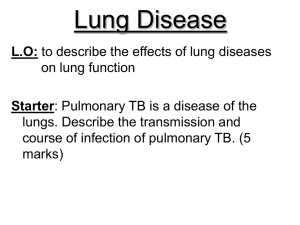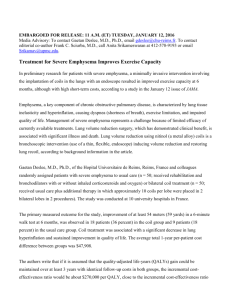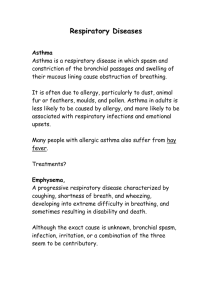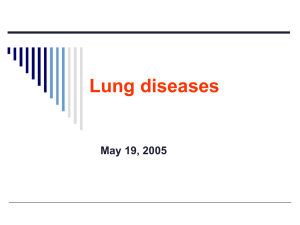Slide 1
advertisement
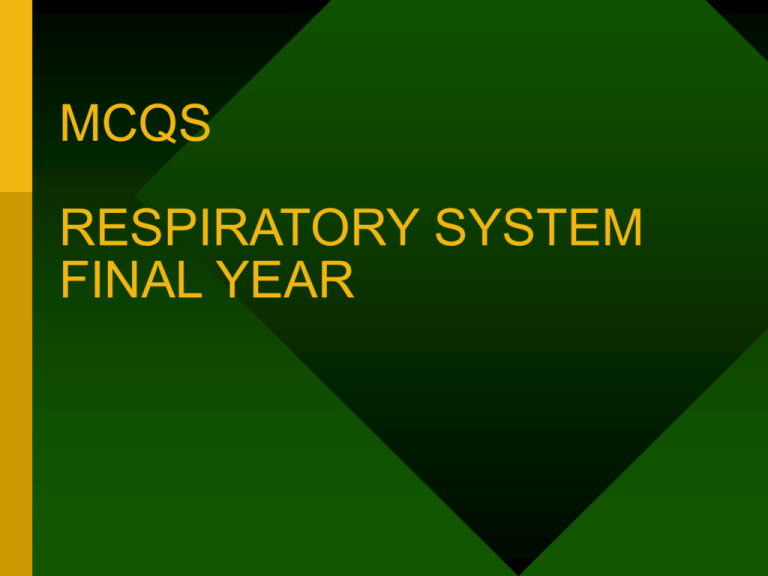
MCQS RESPIRATORY SYSTEM FINAL YEAR MCQ NO • 1 The combined surface area of lungs is: • A.>100m.m • B.>200m.m • C.>300m.m • D.>400m.m • E.>500m.m • 2.What is not true about pneumocytes: – A.Type 1 pneumocytes are flat epithelial cells lining the alveoli. – B.Type 2 pneumocytes are cuboidal and lie deep to type 1 cells. – C.Surfactants are produced by type 1 pneumocytes. – D.Type 1 pneumocytes are formed from type 2 pneumocytes after lung injury. – E.Surfactants are phospholipids that reduce alvelar surface tension and prevent alveolar collapse. • 3.Surfactant is produced by: A.Type1 pneumocytes. B.Type 2 pneumocytes. C.Goblet cells. D.Pulmonary macrophages. • 4.The gas exchange unit of lung is: A.Acinus. B.Alveolus. C.Terminal bronchiole. D.Respiratory bronchiole. 5.Hypercapnia implies blood PaCo.o above: A.5KPa B.6KPa C.7KPa D.8KPa 6.Raised PaCo2 is a feature of all the following except: A.Central sleep apnea. B.Kyphosclerosis. C.Brainstem lesion. D.Ankylosing spondylitis. 7.Which one of the following forms of hypoxemia is not corrected by O2 A.Poorly ventilated lungs. B.Alveolar hypoventilation. C.Impairment of diffusion. D.Right to left shunts. E.None of above. • 8.What is not true about PaCO2 – – A.At age of 20 PaCo.o is around 90 mm of Hg. B.At age of 80 PaCo.o is around 80 mm of Hg. – C.PaCO2 is reduced in emphysema due to reduced area available for gas exchange. – D.PaCO2 remains normal irrespective of whether one is lying or standing. – E.None of above. 9.The normal lung defences include which of the following. A.Mucocillary clearence of particulate matters. B.Surfactant protein A. C.Alveolar macrophages. D.Complement and defensins. 10.Which one of the following is not the feature of Kartageners syndrome. A.Autosomal recessive disorder. B.Situs solitus. C.Male infertility. D.Bronchiectasis. E.Sinusitis 11.Match the breath sounds with corresponding lung pathology. 1.High pitched bronchial A.Bronchitis 2.Low pitched bronchial B.Consilidation 3.Amphoric C.Fibrosis 4.Vesicular with prolonged D.Cavity expiration 12.Mediastianal displacement occurs towards the lung lesion in. A.Collapse B.Fibrosis C.Pneumonia D.All of above E.A and B • 13.Whispering pectorology is absent in. A.Pleural effusion B.Collapse C.Consolidation D.Cavity 14.End inspiratory crepitations uninflunced by coughing implies. A.Cavitation. B.Consolidation C.ILD D.Bronchiectasis 15.Low pitched bronchial breathing is heared in. A..Lobar pneumonia B.Collapse. C.Localised fibrosis D.Pulmonary cavitation 16.Tinkling crepitation when present imply. A.Fibrosing alveolitis B.Hydropneumothorax. C.Pneumothorax D.Bronchiectasis 17.CT scan is valueable in lung diseases for all expect. A.Interstitial fibrosis B.Bronchiectasis C.Mass lesion D.Rib involvement E.Lymphatic spread 18.Ventilation perfusion imaging is valuable in. A.Pneumonia. B.Interstitial lung disease C.Pulmonary embolism D.Emphysema 19.Abrams needle is used for. A.Pleural biopsy B.Renal biopsy C.Liver biopsy D.Peritonial biopsy 20.In asthma one should test antibodies against. A.Legionella. B.Mycoplasma C.Aspergillus D.Chlamydia 21.Which of the following measurements is little value in restrictive lung disease A.VC B.FEV1 C.FEV1 to VC D.FVC E.PEFR 22.All of the following respiratory diseases can produce acute dyspnea at rest except A.Acute sever asthma B.Pneumonia C.Lobar collapse D.Mild pleural effusion E.Pneumothorax 23.Psychogenic hyperventilation is diagnosed from. A.Inability to take a deep breath B.Frequent sighing / erratic ventilation at rest C.Resting end tidal CO2 < 4.5% D.All of above 24.Which of the following is not a very common cause of haemoptysis. A.Tuberculosis B.Bronchogenic carcinoma C.Haemophilia D.Mitral stenosis 25.Investigations of haemoptysis include all except . A.CT scan B.Bronchoscopy C.Pleural biopsy D.Ventilation perfusion scan 26.Which one of the following is not a common cause of solitary pulmonary nodule. A.Tuberculoma B.Bronchogenic carcinoma C.Canon ball metastasis D.Rheumatoid nodule 27.Pneumonia causes which type of respiratory failure. A.Type1 B.Type2 C.Mixed 28.All the following causes type2 respiratory failure except. A.COPD B.Pneumothorax C.Lung fibrosis D.Ankylosing spondylitis 29.The physical signs of CO2 retention are. A.Confusion B.Bounding pulse C.Flapping tremor D.Papilledema E.All of above 30.Which of the following conditions predispose to sleep apnea/ hypopnea A.Obesity B.Male sex C.Acromegaly D.Hypothyroidism E.All of above 31.Apnea is the terminology when breathing pause exceeds. A.5 Seconds B.10 Seconds C.15 Seconds D.20 Seconds E.30 Seconds 33.Consequence of hypoxemia include all except A.Systemic hypotension B.Pulmonary hypotension C.Polycythemia D.Tachycardia 34.Indications for heart-lung transplant rather than single lung transplant include all except A.Primary pulmonary hypertension B.Eisenmengers syndrome C.Cystic fibrosis D.Emphysema 35.100%oxygen inhalation is likely to cause A.Retrolental fibroplasias B.Pulmonary edema C.Both of the above D.None of the above 36.Complications of mechanical ventilation include A.Tracheal stenosis B.Bronchopulmonary dysplasia C.Pneumothorax D.Diminished cardiac output E.All of above • 37.The single most important cause of COPD is. • A.Smoking • B.Air pollution • C.Allergy • D.Individual susceptibility • 38.COPD encompasses all except. • A.Chronic asthma • B.Chronic bronchitis • C.Chronic bronchiectasis • D.Emphysema 39.Complications of chronic bronchitis include all except. A.Respiratory failure B.Pulmonary hypertension C.Polycythemia D.Lung cancer E.Cardiac failure 40.Which of the following is not a finding in lung function test in chronic bronchitis. A.Reduced FEV1 B.Increased lung volume [TLC and RV] C.Normal gas transfer D.Reduced PEFR E.A fall in PaCO2 41.Clinical abnormalities found in patients of advanced air flow obstruction include all except. A.Barrel chest B.Jugular venous filling during expiration C.Tracheal descent during expiration D.Excavation of suprasternal and supraclavicular fossae E.Contraction of sternomastoid and scalene muscle. F.Abdominal retraction during inspiration 42.Purse lips breathing is characteristic of. A.Pneumonia B.Chronic bronchitis C.Emphysema D.Pneumothorax 43.Physical signs of emphysema include all expect. A.Barrel chest B.Diminished cardiac and hepatic dullness. C.Decreased breath sounds D.Symmetrically diminished chest expansion. E.Cyanosis 44.Chest Xray and PFT abnoramilities in emphysema include all except. A.Hypertranslucent lung fields with loss of peripheral vascular markings B.Low flat diaphragm. C.Prominant hilar shadow D.Normal gas exchange E.Reduced FEV1 to VC ratio 45.Smokers with emphysema have predominant involvement of A apex B base C middle segment D no prediction 46 In COPD long term O2 therapy be considerered in present of A pao2 <8 kpa B pulmonary hypertention C nocturnal hypoxemia D combination of all factors E any of the above 47 characteristic pathological changes in asthma include all except A inflammatory cell infiltration B edema of the mucosa C hypertrophy of bronchial smooth muscle D alveolar edema E mucus plugging 48 which type of the cell participate in asthma A mast cell B eosionophils C macrophages D t lymphocytes E all of above 49 in chronic asthma which all have no major role A mast cell B Eosinophil C t cells D non of above 50 interlukine that delays eosionphil apoptosis and this lead to chronic asthma is A IL 2 B IL 5 C IL8 D IL15



